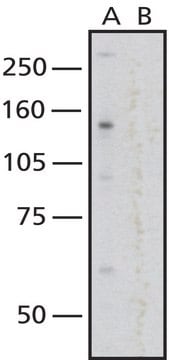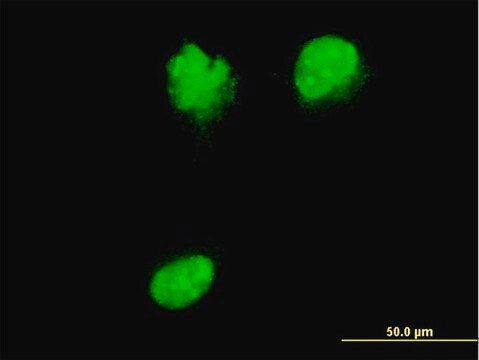MABS1267
Anti-Nuclear Pore Complex Proteins Antibody, clone 414
clone 414, from mouse
Synonim(y):
Nuclear pore glycoprotein p62, 62 kDa nucleoporin, Nucleoporin Nup62, Nuclear pore complex proteins
About This Item
Polecane produkty
pochodzenie biologiczne
mouse
Poziom jakości
forma przeciwciała
purified immunoglobulin
rodzaj przeciwciała
primary antibodies
klon
414, monoclonal
reaktywność gatunkowa
yeast, mouse, rat, human
metody
electron microscopy: suitable
immunocytochemistry: suitable
immunoprecipitation (IP): suitable
western blot: suitable
izotyp
IgG1κ
numer dostępu NCBI
numer dostępu UniProt
docelowa modyfikacja potranslacyjna
unmodified
informacje o genach
human ... NUP62(23636)
Opis ogólny
Specyficzność
Immunogen
Zastosowanie
Immunocytochemistry Analysis: A representative lot immunostained yeast nuclear envelope with a punctate and patchy pattern (Aris, J.P., and Blobel, G. (1989). J. Cell Biol. 108(6):2059-2067).
Immunocytochemistry Analysis: Representative lots detected a punctate staining pattern of Nup62 at the nuclear rim by fluorescent immunocytochemistry using 2% formaldehyde-fixed, methanol-permeabilized Buffalo rat liver (BRL) cells (Davis, L.I., and Blobel, G. (1987). Proc. Natl. Acad. Sci. U. S. A. 84(21):7552-755; Davis, L.I., and Blobel, G. (1986). Cell. 45(5):699-709).
Electron Microscopy: A representative lot immunostained yeast nuclear envelope using 3% paraformaldehyde/0.2% glutaraldehyde-fixed yeast nuclei LR White sections (Aris, J.P., and Blobel, G. (1989). J. Cell Biol. 108(6):2059-2067).
Electron Microscopy: A representative lot immunostained the pore complexes in thin sections of isolated rat liver nuclei extracted with 2% Triton X-100 and fixed with 0.05% glutaraldehyde (Davis, L.I., and Blobel, G. (1986). Cell. 45(5):699-709).
Immunoprecipitation Analysis: A representative lot immunoprecipited a ~100 kDa (p110) and a ~95 kDa (p95) protein species from yeast nuclear extract. An additional ~55 kDa protein was immunoprecipitated by clone 414 using yeast cytosolic fraction or whole cell lysate (Aris, J.P., and Blobel, G. (1989). J. Cell Biol. 108(6):2059-2067).
Immunoprecipitation Analysis: A representative lot immunoprecipitated three major GlcNAcylated prtoein species of 62, 175, and 270 kDa from SDS-solubilized pore complex-lamina extract of Buffalo rat liver (BRL) cell nuclei preparation that had been labeled with UDP-[3H]Gal by galactosyltransferase (Davis, L.I., and Blobel, G. (1987). Proc. Natl. Acad. Sci. U. S. A. 84(21):7552-755).
Immunoprecipitation Analysis: A representative lot immunoprecipitated GlcNAcylated 62 kDa protein (p62) from the SDS-solubilized pore complex-lamina extract, as well as a less glycosylated p61 cytoplasmic form from the postmitochondrial supernatant of Buffalo rat liver (BRL) cells (7552-755; Davis, L.I., and Blobel, G. (1986). Cell. 45(5):699-709).
Western Blotting Analysis: A representative lot detected a ~100 kDa (p110) and a ~95 kDa (p95) immunoreactive bands in yeast nuclear extract (Aris, J.P., and Blobel, G. (1989). J. Cell Biol. 108(6):2059-2067).
Western Blotting Analysis: A representative lot detected a ~62 kDa (p62) and a ~200 kDa target bands associated with nuclear pore complex-lamina of rat liver nuclei preparation even following sequential nucleaases, Triton X-100, and 140 mM NaCl treatments (Davis, L.I., and Blobel, G. (1986). Cell. 45(5):699-709).
Signaling
Chromatin Biology
Jakość
Immunocytochemistry Analysis: A 1:200 dilution of this antibody immunostained HeLa cell nuclear rim.
Opis wartości docelowych
Postać fizyczna
Przechowywanie i stabilność
Inne uwagi
Oświadczenie o zrzeczeniu się odpowiedzialności
Not finding the right product?
Try our Narzędzie selektora produktów.
Kod klasy składowania
12 - Non Combustible Liquids
Klasa zagrożenia wodnego (WGK)
WGK 1
Temperatura zapłonu (°F)
Not applicable
Temperatura zapłonu (°C)
Not applicable
Certyfikaty analizy (CoA)
Poszukaj Certyfikaty analizy (CoA), wpisując numer partii/serii produktów. Numery serii i partii można znaleźć na etykiecie produktu po słowach „seria” lub „partia”.
Masz już ten produkt?
Dokumenty związane z niedawno zakupionymi produktami zostały zamieszczone w Bibliotece dokumentów.
Nasz zespół naukowców ma doświadczenie we wszystkich obszarach badań, w tym w naukach przyrodniczych, materiałoznawstwie, syntezie chemicznej, chromatografii, analityce i wielu innych dziedzinach.
Skontaktuj się z zespołem ds. pomocy technicznej








